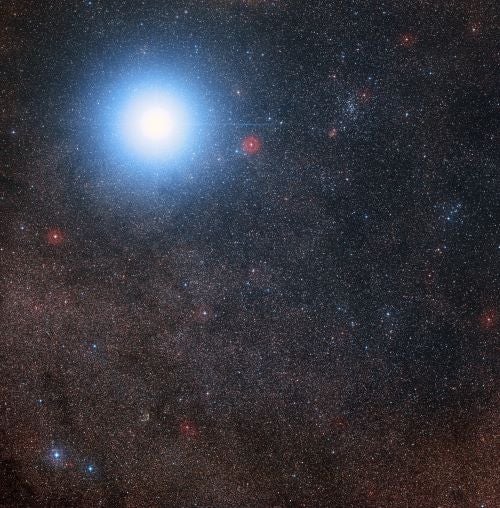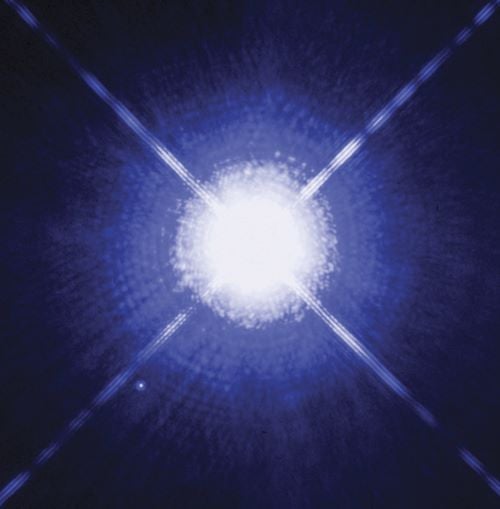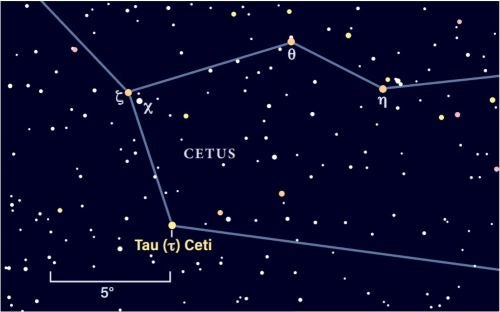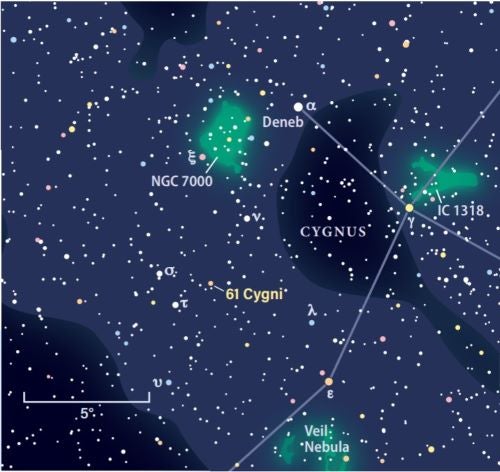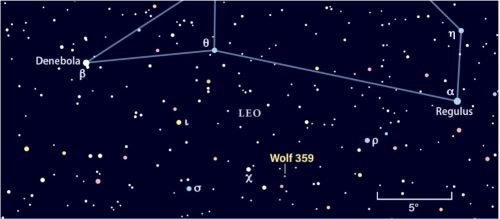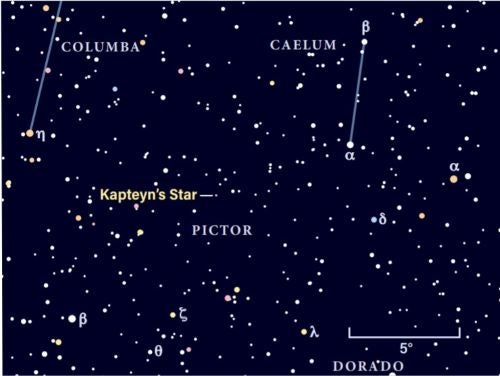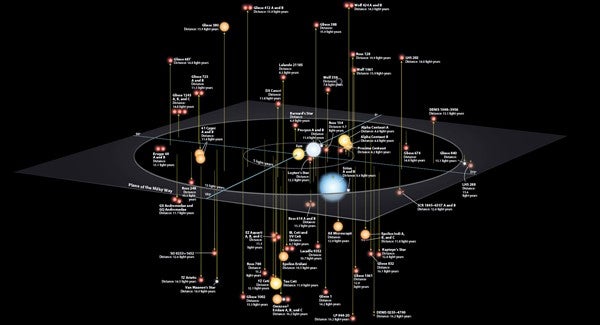We get so consumed with what’s beyond our galaxy that we forget that our own stellar neighborhood is pretty fascinating. Sure, we’re surrounded by mostly faint red dwarf stars, but they are our nearest stellar neighbors and we interact with them on timescales of tens of thousands of years.
With the exceptions of Sirius, the brightest star in the night sky, and Alpha Centauri, none of these stars shows up easily to the naked eye. But they have influenced our solar system’s evolution in the past and will continue to do so in the future.
We often hear about our neighbors in the Alpha Centauri system, which includes Proxima Centauri, the closest known star to Earth at only 4.2 light-years away. But let’s take a look at some other fascinating stars, all of which lie within 15 light-years of Earth.
Runaway star
At just 6 light-years away, Barnard’s Star has the fastest proper motion (motion across our line of sight) of any known star and is steadily making its way north through eastern Ophiuchus. Its discovery serendipitously stemmed from a number of galactic surveys started by American astronomer Edward Emerson Barnard in the early 1890s, when he began using Yerkes Observatory’s 40-inch refractor.
In 1916, while examining a photograph of a region in Ophiuchus, Barnard noticed what he thought was an undiscovered star. By comparing an August 1894 plate of the same region, he found the magnitude 9.5 star — but some 4′ from its 1916 position. Examination of a 1904 plate of the same part of the sky showed that this new star was traveling at a rapid pace. It was later christened Barnard’s Star.
At some 10 billion years old, roughly twice the age of our Sun, Barnard’s Star is among the oldest within Earth’s vicinity. This red dwarf is the closest known single star to our Sun and appears relatively inactive.
Van de Kamp arrived in 1937 at Swarthmore College’s Sproul Observatory, where he began surveying nearby stars with the 24-inch refractor. Over the following decades, he took thousands of plates of Barnard’s Star (as I note in my book Distant Wanderers: The Search for Planets Beyond the Solar System [Copernicus, 2002]). By 1963, van de Kamp had accumulated enough data to announce that it had a perturbation in its proper motion, which he claimed indicated a planet 1.6 times the mass of Jupiter with an orbital period of 25 years.
Van de Kamp’s claims were largely discounted after it became known that the telescope had a history of structural problems that contributed to the star’s perceived perturbations. His images were also generally underexposed, which enhanced small displacements of one star in comparison to another.
All refractors have similar issues: tube and lens flexure, thermal lens aberration changes, atmospheric seeing, and refraction variations, as well as color effects, says Philip Ianna, an astronomer at the Research Consortium on Nearby Stars Institute in Chambersburg, Pennsylvania.
“The Sproul people deserve credit for working diligently to sort out and understand their flaws,” says Ianna. “Other long-focus refractors are not known to have ‘flaws’ because no one has studied them adequately.”
In 2018, Barnard’s Star finally got a bona fide planetary detection. But its 3.2-Earth-mass planet lies close to the system’s so-called “snow line,” where water condenses into ice. Thus, even though the planet is close to its parent star, 0.4 astronomical unit away (1 AU equals the average Earth-Sun distance), it may still be inhospitable.
According to Eric Mamajek, an astronomer at the University of Rochester in New York, future study of Barnard’s Star will likely tell astronomers how planet formation turns out for a star about one-sixth the mass of the Sun, but that has only about a third, or less, of its metal content.
Winter’s gem
Sirius (Alpha [α] Canis Majoris) captured the attention of early skygazers. Its heliacal rising (its first visibility in the east before sunrise) each year made it important to the Egyptians, who worshipped it as the goddess Sopdet and saw its appearance as heralding the Nile River’s beneficial annual flooding.
The term “dog days of summer” comes from the ancient Greeks, who believed Sirius’ annual appearance brought the worst of the summer’s hot and dry period. They feared this bright star would literally cause people to go mad, and called anyone thought to be affected by Sirius’ brightness “starstruck.” That’s hardly the current use of the term, but it does explain its origins. Thus, the days coinciding with Sirius’ annual reappearance from July 3 through August 11 were dubbed “dog days.”
In 1844, German astronomer Friedrich Bessel deduced from changes in Sirius’ proper motion that it has an unseen companion. In 1862, American telescope maker Alvan Graham Clark was testing a lens in Cambridgeport, Massachusetts, when he first observed Sirius B.
Then, in 1915, the 60-inch reflector at Mount Wilson observatory in California characterized Sirius B as a whitish star in roughly a six-year orbit around Sirius A. With this new data in hand, astronomers then concluded that Sirius B was a white dwarf, a stellar remnant left behind by a low-mass star.
Sirius B used to be bigger and more luminous than Sirius A, probably about five times the mass of the Sun and nearly a thousand times as luminous during the time it was a main sequence star, says Mamajek. But he says the star exhausted its fuel, became a red giant, and blew off its outer layers about 120 million years ago, leaving behind a dimming, cooling white dwarf.
So, the total mass of the system in the two stars was probably more like seven times that of the Sun, says Mamajek. But now, only about 3 solar masses remain in the system: 2 solar masses in Sirius A and one in Sirius B.
Researchers don’t think the Sirius system harbors planets. That’s in part because the separation between the stars changed when Sirius B expelled most of its mass, which may have caused planetary orbits to destabilize — and perhaps even cross.
This means that any putative planets would have been in a constantly changing dynamical environment, says Adam Kraus, an astronomer at the University of Texas at Austin. He says the odds are high that, at some point, any planet would have been either kicked out of the system or kicked into one of the stars.
“It would have been astounding to witness the changes that have taken place in the Sirius binary system over its astrophysically short life span,” says Mamajek.
Anyone home?
Tau (τ) Ceti, a Sun-like spectral type G star only 12 light-years away in Cetus, is the closest known solitary G-type star to the Sun. It’s best known as the first star to be searched for signs of intelligent life. That’s because in April 1960, American astronomer Frank Drake attempted to detect interstellar transmissions from the vicinity of the star using the 26-meter telescope at the National Radio Astronomy Observatory’s Green Bank facilities in West Virginia. Of course, he came up empty, but it marked an important milestone in the advancement of the search for extraterrestrial intelligence.
Slightly cooler and less luminous, but with a longer lifetime than our Sun, Tau Ceti has radiation and evolutionary characteristics that make it and other cooler G and K dwarf stars near-perfect hosts for habitable planets, says Guinan. For these reasons, we refer to them as Goldilocks stars, he says. These less luminous stars have main sequence, hydrogen-burning lifetimes that are typically two to three times longer than our Sun, and Guinan says planets orbiting them would, in theory, have stable long-term climates.
No answer
As I also note in my book, “the late Kaj Strand, the first astronomer to claim the ‘detection’ of an extrasolar planet, did so when the rest of the world was more concerned about events here on Earth.” I write that Strand based his 1943 claim on his observations of 61 Cygni, a binary star system 11.4 light-years away in Cygnus. Unfortunately, Strand was using the Sproul Observatory refractor when he claimed that 61 Cygni had an unseen companion 16 times the mass of Jupiter. His claims were never substantiated. In fact, 61 Cygni is a binary system which consists of two K dwarf stars.
Engage!
As the fifth-nearest star system and an active red dwarf, Wolf 359 has earned a special place in the hearts of Star Trek fans. It’s where the United Federation of Planets suffered a devastating defeat at the hands of the Borg Collective in the year 2367, in the TV series Star Trek: The Next Generation.
“I have to admit that I started observing Wolf 359 over 20 years ago in part because of its Star Trek fame,” says Guinan. Thought to be less than a billion years old, it’s an M dwarf that lies only 8 light-years away in Leo. Unfortunately, Guinan reports that there have been no planets observed circling Wolf 359.
Heading our way
The red dwarf star Ross 128, which American astronomer Frank Elmore Ross placed in a catalog of high-proper-motion stars, is the 12th-closest stellar system to Earth. It lies only 11 light-years away in the constellation Virgo the Maiden and is now known to have an Earth-sized exoplanet that orbits this faint star roughly every 10 days.
Although that’s incredibly close to its parent star, the planet receives only 1.38 times more radiation than Earth. As a result, its temperature is estimated to range up to as high as 68 degrees Fahrenheit (20 degrees Celsius). But it’s still uncertain whether the planet, designated Ross 128 b, lies inside this system’s habitable zone, much less whether its surface harbors liquid water.
Ross 128 is moving in our direction. In less than 80,000 years, it’s expected to replace Proxima Centauri as our nearest stellar neighbor.
Not so heavy
Lying some 13 light-years away in the far-southern constellation Pictor, Kapteyn’s Star likely takes the cake as one of the most metal-poor stars out there. (Metals, to astronomers at least, are any elements heavier than helium.) Yet it is thought to be orbited by two super-Earth-mass planets. Given that Kapteyn’s Star likely originated in the halo of our galaxy, this would make its planets some of the oldest ever detected in the habitable zone of another star.
“It’s good to see that super-Earth planets can form in such low-metal environments,” says Guinan. He says this gives hope that the hundreds of millions of metal-poor stars located in the oldest and most metal-poor parts of our Milky Way Galaxy could also host planets.
“When I think about the planet candidate Kapteyn b, I wonder about the possibility of life some 6 billion to 7 billion years older and possibly more advanced than us,” says Guinan.
“Future study of the Kapteyn system,” says Mamajek, “will help astronomers learn how planetary systems around low-mass stars evolve when the parent star only starts out with a metal content that is a tenth that of our Sun.”
Successful search
Finally, there’s Teegarden’s Star, which is the only star named after a living person. This M dwarf, located some 12 light-years away in Aries, was found in 2003 after now-retired NASA Goddard Space Flight Center astrophysicist Bonnard Teegarden began looking for high-proper-motion stars using Near-Earth Asteroid Tracking data.
“Initially, astronomers thought the star was among the nearest, but more accurate parallax measurements show that it is at a distance of 12 light-years, making it the 27th-closest star,” Teegarden says.
The nearest now
The four closest systems are currently believed to be Alpha Centauri (A, B, and Proxima), Barnard’s Star, WISE 1049–5319, and WISE 0855–0714.
WISE 1049–5319 is a young binary system consisting of two brown dwarfs, discovered in 2015 and located some 6.5 light-years away in Vela. WISE 0855–0714 lies at a distance of just over 7 light-years in Hydra. The two have bumped Wolf 359 from the Sun’s third-nearest stellar neighbor.
Guinan wonders whether WISE 0855–0714 could even be a rogue planet. “WISE 0855–0714 is very faint and cool, and is more like a large Jupiter planet than a star,” says Guinan. “If it is a super-Jupiter, it may have been ejected from its birthplace star system and is more like a rogue planet. If any of these rogue planets got too close to our solar system, it would be disastrous for us.”
One passage of a body like WISE 0855–0714, even at a distance of 50 AU, could disrupt the solar system, he says.
Stellar census
Just how many nearby M dwarfs and smaller stars might be nearby?
There may be some stars within a few parsecs (1 parsec equals about 3.26 light-years) of the Sun that still haven’t been recognized, but most of the discovery space likely lies in very low-mass L, T, and Y dwarfs, says J. Davy Kirkpatrick, an astronomer at Caltech. These include stars that range down to masses of small, stellar-type objects known as brown dwarfs. Finding those — particularly the cold Y dwarfs, says Kirkpatrick — will require going to far-infrared wavelengths, where they emit most of their radiation.
“It is likely that the nearest dozens of stars, especially Sun-like ones, will be the best targets for directly imaging light from planets similar to Earth,” says Mamajek. However, he says, recent observations seem to suggest that small stars have lots and lots of small planets.
But Kraus says astronomers are starting to find that planets are substantially less common in binary systems, especially those on the scale of the solar system. He says planets do form and survive, though, even in very dynamically active environments.
Space missions like NASA’s Transiting Exoplanet Survey Satellite (or TESS) are surveying the brightest M dwarfs for transiting planets, says Jennifer Winters, an astronomer at the Harvard-Smithsonian Center for Astrophysics. But, she adds, even if all M dwarfs have planets, only a fraction of them will have the optimal alignment to our line of sight that would enable them to be observed. Thus, only an estimated one of 30 M dwarfs with a radius about a tenth to a third that of our Sun will be detectable.
“We not only want to detect the planets; we want to characterize them by studying their atmospheres to see if they could harbor life,” says Winters.
It’s critical to understand how a given star’s flares impact exoplanet atmospheres at different wavelengths, says Knicole Colon, an astronomer at NASA’s Goddard Space Flight Center in Maryland. NASA’s upcoming James Webb Space Telescope has the potential to precisely characterize infrared activity on the closest stars, she says, and therefore contribute to our understanding of the impact of stellar activity on the exoplanets that orbit them.
We need to know what a given star’s ultraviolet and X-ray output actually is, says Winters, while noting that it would also “be awesome if we could send robotic probes out to individual stars for in-depth studies.”
While four NASA probes launched in the 1970s continue to make their way into the interstellar depths, the space agency appears to have largely abandoned the idea of such a mission. Of course, NASA’s New Horizons Pluto flyby performed stunningly well. And given its current velocity, it will eventually reach interstellar space — perhaps with enough fuel to continue providing telemetry data to its ground-based controllers.
The four spacecraft will eventually pass by several of our stellar neighbors within the next few million years. Although they will all have long ceased operation by then, astronomer Coryn Bailer-Jones at the Max Planck Institute in Heidelberg, Germany, has used data from the European Space Agency’s Gaia spacecraft to calculate which stars they are most likely to pass.
In about 40,000 years, Voyager 1 will pass the nearest star, Proxima Centauri. Voyager 2 and Pioneer 10 will pass Ross 248, some 10 light-years away in the constellation Andromeda. In some 928,000 years, Pioneer 11 will pass within a light-year of the red dwarf star TYC 992-192-1.
A comforting thought
Perhaps the recent film Ad Astra, set in our near future, sums this up best. The main character marvels at the fact that his father was the first person to reach the outer solar system; that’s no small feat, given that Uranus and Neptune are 19 and 30 AU away, respectively.
As the film reminds us, beyond the hazards of cosmic radiation and our own psychological frailties, the biggest challenge in space is the void. Nevertheless, it’s comforting to contemplate our local neighborhood. Despite the peril and seeming impossibility of actually getting there, it’s heartening that we are somehow connected to these nearby stars.

